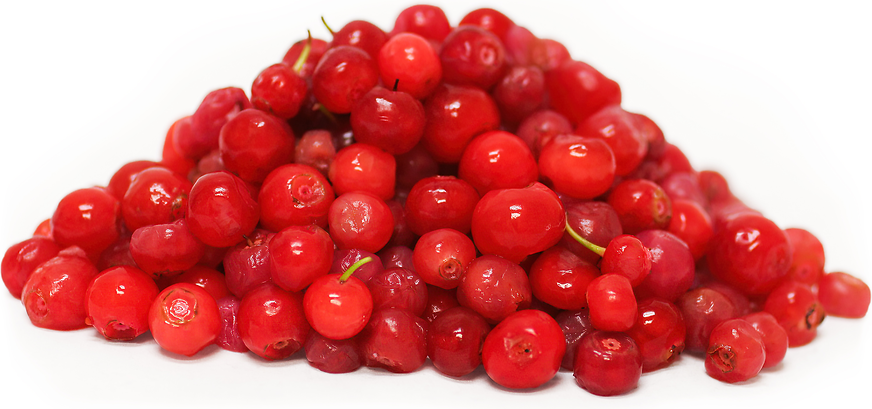


Red Huckle Berries
Estimated Inventory, lb : 0
Description/Taste
Red huckleberries are small fruits that grow on slender stems and reach about 6 to 10 millimeters wide. They have a blueberry-like appearance with a circular shape and a crown at the bottom of their body. These fruits have a faded pink-red to bright-red skin that’s shiny, smooth, and slightly transparent. Their skin may possess light wrinkling and faint bruising in some areas. Red huckleberries have a tender flesh with a subtle crunch due to the numerous hard seeds they contain. These berries offer a lingering sweet-tart finish with flavors of cranberry, rhubarb, red currant, and blueberry along with a hint of acidity.
Seasons/Availability
Red huckleberries are available from mid-summer to early fall.
Current Facts
Red huckleberries are botanically classified as Vaccinium parvifolium and belong to the Ericaceae family which also includes blueberries, cranberries, lingonberries, wintergreen, azalea, and bog rosemary. Red huckleberries are also known as Red Whortleberry and Red Bilberry. This variety's relation to blueberries caused early American settlers to confuse the two fruits. They then labeled huckleberries as European blueberries and named them hurtleberries. It wasn’t until the 1670s that they were officially renamed huckleberries. The key difference between blueberries and huckleberries is that the latter typically contains 10 relatively large seeds while blueberries have numerous tiny seeds that are barely noticeable. Red huckleberries are the edible fruit of deciduous shrubs that grow 1 to 4 meters tall and are found in coastal forests of the American Pacific Northwest. These plants can be grown as ornamentals due to their green and pink flowers but may also be used in culinary applications.
Nutritional Value
Red huckleberries are a good source of vitamins A, B, and C. Vitamin A is crucial for eye health and skin integrity while B vitamins play a role in energy production and cognitive function. Vitamin C acts as a powerful antioxidant to promote immune defense and aid in collagen production. Red huckleberries are also rich in antioxidants like anthocyanins and polyphenols. These help combat oxidative stress, reduce inflammation, and contribute to cellular health. Anthocyanins are responsible for the berry's vibrant color and are linked to heart health and cognitive support. Red huckleberry leaves have been widely used to lower or modify blood sugar levels. Huckleberry tea is said to help alleviate glycosuria, hyperglycemia, sore throats, colds, and inflamed gyms. They have also been used as an adjunct treatment to diabetes.
Applications
Red huckleberries may be consumed fresh but their distinctly tart flavor is more frequently enjoyed in cooked, dried, or juiced applications. These fruits are often used as an ingredient in pies, cakes, cobblers, muffins, preserves, syrups, and reductions. They may be used similarly to red currants or cranberries in sauces for chicken, turkey, or wild game. Red huckleberries are often mixed into beverages like smoothies, green juices, milkshakes, teas, and wines. They can be incorporated into quinoa bowls made with chickpeas, lemon, and shredded carrots or used as an ingredient in holiday stuffings. These berries frequently top breakfast foods like oatmeal, waffles, pancakes, and yogurt parfaits. They are also dried to create fruit leathers. Red huckleberries pair well with raspberries, blueberries, brambleberries, honey, maple syrup, cinnamon, ginger, nutmeg, cloves, cumin, basil, tarragon, almonds, walnuts, chia seeds, salmon, lamb, pork, and fresh cheeses like burrata, feta, and goat.
Ethnic/Cultural Info
Native American tribes have foraged Red huckleberries from the wild for generations. The Skallam, Lummi, Makah, Quileute, Quinault, Skagit, Skokomish, Snohomish, and Swinomish tribes all utilized the berries in various ways. They consumed them fresh, dried, preserved, mashed into cakes, or pressed into oil for winter storage. Red huckleberries were also used as fish bait because they resembled salmon eggs. They were commonly eaten with another foraged berry from the Pacific Northwest called salal or consumed with oil and animal grease. Despite the significant cultural losses many Native Americans have experienced over the past few centuries, these tribes remain committed to actively restoring wild huckleberry populations.
Geography/History
Red huckleberries are native to the Pacific Northwest of North America. They grow wild along the Pacific Coast stretching from Southeastern Alaska to Central California. These berries flourish in temperate climates with high moisture and partial sun to partial shade. These areas have warm daytime temperatures around 28 degrees Celsius and cool nighttime temperatures of about 13 degrees Celsius. Red huckleberry's preferred habitats include decaying logs and stumps within coniferous, lowland, and hardwood forests. They are frequently foraged from the wild or sown in home gardens. Red huckleberries have a limited seasonal availability and sensitive post-harvest shelf-life that reduce their commercial appeal. They may be found during their peak season at farmers’ markets or specialty stores along the Pacific Coast regions of North America.
Recipe Ideas
Recipes that include Red Huckle Berries. One
| Baking the Goods |
|
Huckleberry Hand Pies |
| The Bojon Gourmet |
|
Lemon Huckleberry Tea Cake |




